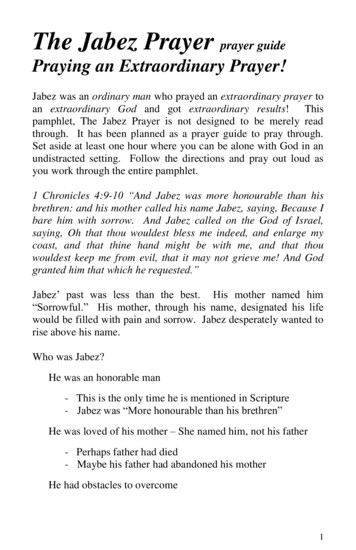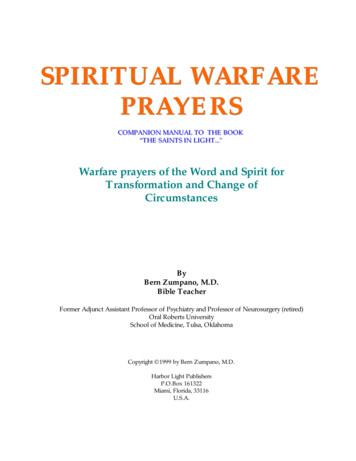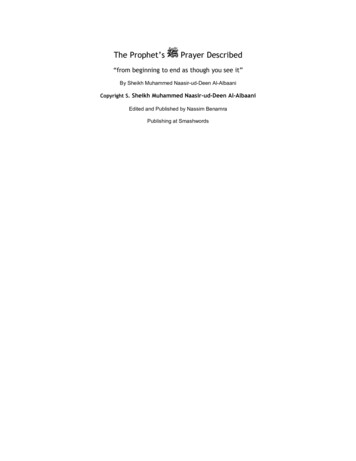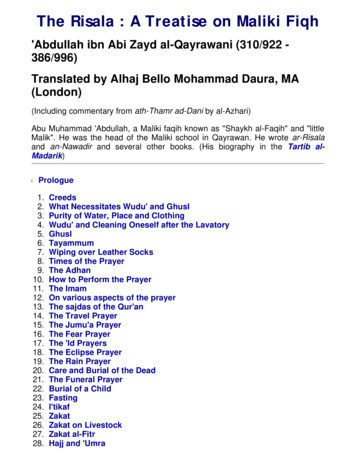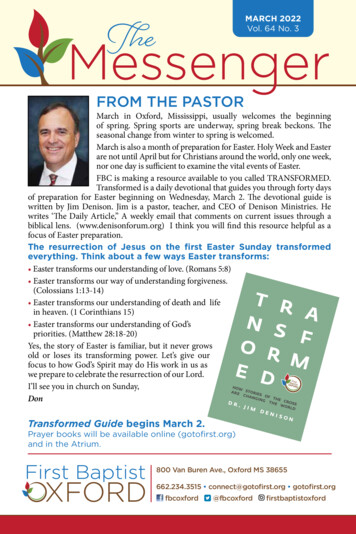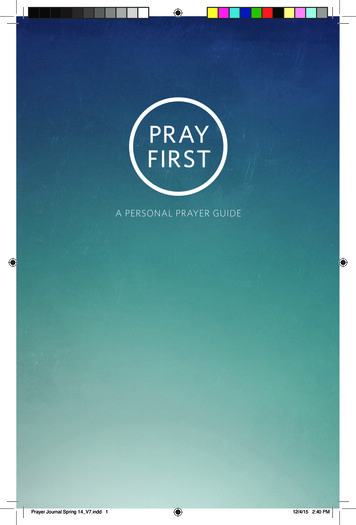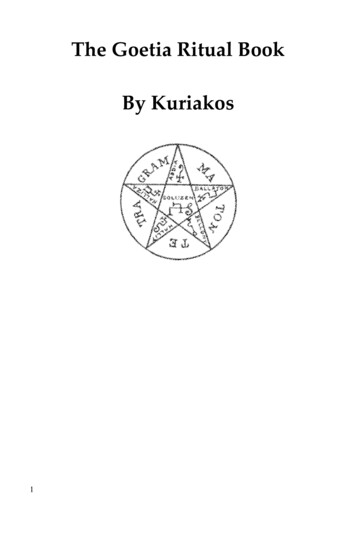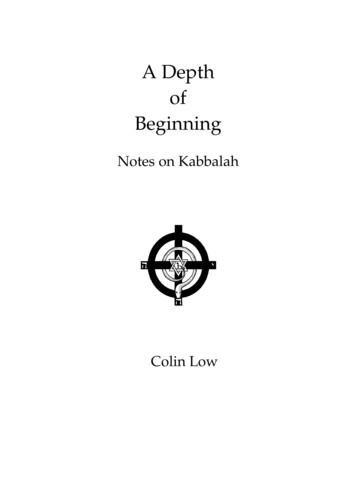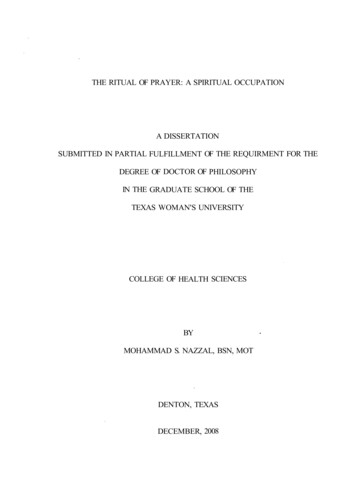
Transcription
THE RITUAL OF PRAYER: A SPIRITUAL OCCUPATIONA DISSERTATIONSUBMITTED IN PARTIAL FULFILLMENT OF THE REQUIRMENT FOR THEDEGREE OF DOCTOR OF PHILOSOPHYIN THE GRADUATE SCHOOL OF THETEXAS WOMAN'S UNIVERSITYCOLLEGE OF HEALTH SCIENCESBYMOHAMMAD S. NAZZAL, BSN, MOTDENTON, TEXASDECEMBER, 2008
TEXAS WOMAN'S UNIVERSITYDENTON, TEXASNOVEMBER 6, 2008DateTo the Dean of the Graduate School:I am submitting herewith a dissertation written by Mohammad S. Nazzal, entitled "Theritual of prayer: A spiritual occupation." I have examined this dissertation for form andcontent and recommend that it be accepted in partial fulfillment of the requirements forthe degree of Doctor of Philosophy with a major in Occupational Therapy.We have read this dissertation andrecommend its acceptance:Q/4« (# Director, School of Occupational TherapyDean of the Graduate School
Copyright Mohammad S. Nazzal, 2009All rights reserved.lll
ACKNOWLEDGEMENTAll thanks are due to Allah, the Most Gracious, Most Merciful, for all hisblessings on me. Nothing can be accomplished without his grace. I especially thank mydissertation advisor Dr. Gayle Hersch, professor of Occupational Therapy, for herongoing guidance, teaching, support, and encouragement. I appreciate her for being aprofessor, a mentor and a friend. I also thank Dr. Sally Schultz and Dr. Josephine Chan,professors of Occupational Therapy and Dr. Evelyn Anderrsson, Assistant Professor ofOccupational Therapy, for their invaluable feedback and significant contributions to thefocal points of this dissertation. I would like to specially thank Dr. Suzanne Peloquin,professor of occupational therapy, for her valuable intellectual discussions andsuggestions throughout the dissertation research process.I thank my late mother and father for instilling in me the importance of education.I remember them for their endless love and prayers. I thank them, though being illiterate,for being dedicated to build a family that honors values, education and hard work. I cannot thank my close family the way they deserve. I thank the love of my life, my wifeKhitam, my daughter Alisar and my son Laith, for their love, support, and for just beingthere for me. I apologize for the many times you wanted to include me in your plans and Isaid then "I am busy." I promise I will make it up to you! I also want to thank my family,brothers and sisters in Jordan for their support, love, and prayers. Many thanks to myresearch sites and participants for their time, participation and sharing their experiences.IV
ABSTRACTMOHAMMAD S. NAZZALTHE RITUAL OF PRAYER: A SPIRITUAL OCCUPATIONDECEMBER 2008Occupation is everything people do to occupy themselves, including self-careactivities, work, leisure and play. This line of research explored the ritual of prayer as ameaningful spiritual occupation. The overall purpose of this dissertation was to explorethe occupation of daily prayer, and to bring to the attention of occupational therapists theimportance of spiritual occupations in the lives of their clients.This dissertation includes six chapters. Chapter One introduces the problem, aims,and significance of this line of research. Chapter Two is a literature review of theoccupation of prayer and spirituality, associated issues and effects on health and wellbeing of the individual. Chapter Three explores the meaning, value, and occupationalperformance of prayer to ordinary individuals who regularly perform this occupation.Chapter Four investigates the meaning, value, and occupational performance of prayerfrom the perspective of individuals with physical disabilities. Also, it examines theadaptation process that they experienced in their attempt to perform the occupation ofprayer. Chapter Five pilots the utility of a newly created prayer assessment tool toexamine physical, cognitive, and affective skills and level of community participation.V
Chapter Six summarizes the findings of this line of research, limitations, and implicationsfor occupational therapy.The significant finding of this line of research was that it illustrated the significantmeaning and value of the occupation of prayer to participants with and without physicaldisabilities. The studies revealed the occupational performance skills, contexts, andpatterns inherent to optimal engagement in the occupation of prayer. In addition, itillustrated the adaptation process that individuals with physical disabilities experience intheir attempt to perform the occupation of prayer. Such a process could be therapeuticallyutilized by occupational therapy practitioners to maximize the participation in prayerrituals and other spiritual occupations among individuals who identify themselves withprevious religious roles. The Occupational Measure of Prayer (OMP), although apromising new tool, is still in the first stages of tool development and needs furtherrefinement with the establishment of appropriate psychometric properties.Vl
TABLE OF CONTENTPageCOPYRIGHT . iiiACKNOWLEDGMENTS . ivABSTRACT .VLIST OF TABLES . xiLIST OF FIGURES . xiiChapterI.INTRODUCTION . 1Problem Statement . 1Purpose Statement . 3Specific Aims . 4Significance of Line of Research . . 6II.LITERATURE REVIEW . 8Spirituality and Occupational Therapy. 9Definition of Spirituality . 9Spirituality As a Worthy Concept in Occupational Therapy . 11Boundaries of Provision in Occupational Therapy . 13Modes of Expression of Spirituality . 16Spirituality Link to Meaning . 17Therapeutics of Spirituality. 18A Tool for Hope and Coping . 19A Tool for Physical Exercise . 22A Tool for Cognitive Exercise . 24A Tool for Social Connection . 26Relevance to Habits, Routines, and Rituals . 28Link to Culture . 30Conclusion . 32Vll
III.THE PRAYER RITUAL: VALUE, MEANING AND OCCUPATIONALPERFORMANCE . 33Introduction . 33Purpose Statement . 33Specific Aims . 34Literatrure Review . 34Methodology . 37Design . 37Participants . 38Ethical Considerations . 39Data Collection Procedures . 39Data Analysis Procedures . 40Rigor . 40Results . 41Meaning of Prayer . 41Meaning of Spiritulaity . 44Value of Prayer . 46Occupational Performance . 49Discussion . 55Limitations . 58Conclusion . 59IV.PARTICIPATION IN PRAYER RITUAL: PERSPECTIVES OFINDIVIDUALS WITH PHYSICAL DISABILITIES . 62Introduction . 62Purpose Statement . 63Specific Aims . 64Literatrure Review . 65Definition of Spirituality . 65Spirituality and Disability . 66Spirituality and Occupational Therapy . 67Methodology . 69Design . : 69Participants . 69Ethical Considerations . 71Data Collection Procedures . 71Data Analysis Procedures . 71Rigor . ·. 72Results . 73Meaning . 73Vlll
Value of Prayer . 76Occupational Adaptation Process . 78Discussion . 84Limitations and Future Research . 88Conclusion . 90V.THE OCCUPATIONAL MEASURE OF PRAYER (OMP): A PILOTEXPLORATION . 93Introduction . 93Purpose Statement . 95Specific Aims . 95Literature Review . 96Methodology . 99Research Design and Tool . 99Participants . 99Ethical Considerations . 100Data Collection Procedures . 101Data Analysis Procedures . 101Results . 101Demographics of Participants . 101Occupational Measure of Prayer Domains . 102Discussion . 105Limitations and Future Research . 108Conclusion . 109VI.CONCLUSIONS AND IMPLICATIONS . 115Significant Findings . 117Meaning of Prayer and Spirituality . 117Occupational Adaptation Process . 118Assessment of Prayer . 121Implications . 122Implications for Occupational Science . 122Implications for Occupational Therapy . 123Limitations . 128Recommendations for Future Research . 129Researcher's World Viewpoint and Reflections . 130REFERENCES . 135IX
APPENDICESA.B.C.D.E.F.G.H.I.IRB Approval .Semi-structured Interview Guide for Study One .Guide for Participant-Observation .Semi-structured Interview Guide for Study Two .Semi-structured Interview Guide for Study Three .Occupational Measure of Prayer (OMP) .Addendum to the Occupational Measure of Prayer (OMP) .Consent Forms .Publication Correspondence .X151154157159162164169171182
LIST OF TABLESPageTable1. Demographic Information of Participants of Study One . 602. Occupation of Prayer: Themes and Sub-themes of Study One . 613. Demographic Information of Participants of Study Two . 914. Occupation of Prayer: Themes and Sub-themes of Study Two . 925. Demographic Information of Participants of Study Three . 1116. Themes Analysis of Prayer and Spirituality Meaning and Value Themes . 133Xl
LIST OF FIGURESFigurePage1. Graph Chart of Responses to the Physical Performance Domain . 1122. Graph Chart of Responses to the Cognitive/Affective Performance Domain . 1133. Graph Chart of Responses to the Community Participation Domain . 1144. Application of Occupational Adaptation on Prayer Ritual Performance . 134XU
CHAPTER IINTRODUCTIONMost individuals, no matter what their cultural or geographical background, tendto relate to a higher form of existence (DiJoseph, & Cavendish, 2005; Maier-Lorentz,2004). This relationship with a higher form of existence may be displayed in the form ofa spiritual connection, often called prayer. Abramowitz (1993) refers to prayer as theladder which connects the individual with the higher power. Prayer takes many forms.These include, but are not limited to: supplication; meditation and rehearsing verses ofholy books such as the Bible, Torah or the Quran; using rosary beads; making the sign ofthe cross; and attending houses of worship.Prayer is a universal spiritual activity and its meaning is relative to eachindividual (DiJoseph & Cavendish, 2005; Lenshyn, 2005; Taylor & Outlaw, 2002).Culture and prayer have a strong link. The form, meaning, and significance of prayer willvary according to the cultural and social make up of the individual (Maier-Lorentz,2004).Problem StatementOccupation is considered the medium and the outcome which occupationaltherapists utilize to maximize their client's performance potential. This philosophicalprinciple is based on the inherent assumption that participation in occupations is essentialto one's health and wellbeing (Meyer, 1922; Reilly, 1962; Wood, 1995). Johnson (1973)1
defined occupation as "any goal-directed activity meaningful to the individual andproviding feedback to him about his worth and value as an individual and about hisinterrelatedness to others" (p. 3).One of the occupations that many individuals enjoy performing is prayer. Prayeris one occupation among many within the spiritual realm but has rarely been addressed inoccupational therapy literature. Even though the spiritual context in which the occupationof prayer occurs could be closely connected to the occupational performance of anindividual, this connection has not been acknowledged by most occupational therapists.The Occupational Therapy Practice Framework: Domain & Process [OTPF] (AOTA,2002) considers spirituality as part of the environmental context in which occupation mayoccur (AOTA, 2002). Spirituality is defined as "the fundamental orientation of a person'slife that which inspires and motivates that individual" (AOTA, 2002, p. 623). The OTPFidentifies the spiritual context of occupational performance, yet does not mention prayeras an activity of daily living (ADL). As an area of occupational performance, prayer hasmany performance skills that could be used in therapy. For example, rituals and routines,social communication and community participation could all be addressed byoccupational therapy through prayer.Different forms of prayer from different cultural and religious backgrounds oftenencompass most, if not all, of these skill areas. However, individuals with physical orpsychological conditions may not be able to optimally participate in the meaningfuloccupation of prayer. The occupational therapy profession has a responsibility to meetthe needs of clients and the society we serve (AOTA, 2006). Consequently, occupational2
therapists should explore all areas of occupation that are of interest to our clients andutilize these occupations to maximize their adaptive repertoire and functional capacities.Prayer is one example of an occupation that can be used to facilitate adaptation andfunctional performance.Purpose StatementThe overall purpose of this dissertation was to explore the meaning, value and thedifferent performance aspects of prayer as a meaningful occupation for individuals fromdifferent faiths and cultural backgrounds. Occupation requires active participation andengagement of the individual (AOT A, 1979; Fidler & Fidler, 1978). This basicassumption of occupational therapy is applicable to those forms of prayer that areritualistic and require some kind of physical and cognitive engagement. For the purposeof this dissertation, the researcher defined prayer as: the religious act or event in whichindividuals seek connection with a higher form of existence through physical, mental andritualistic engagement of worship as defined within cultural and religious norms eitherindividually or collectively. As such, this dissertation did not address meditation andintercessory ( distant) forms of prayer (Byrd, 1997). Research articles on the effect ofthese other forms of prayer on health have raised strong but reasonable debate and doubtof its validity from the scientific community (Flannelly, Ellison & Strock, 2004).Also, it should be noted, that the aim of this line of research was not to proposethat individuals should pray to increase their health and wellness, nor to impose theresearcher's views and biases regarding this topic. The main goal of this dissertation wasto explore the meaning of spiritual activity; the occupational spiritual behavior rather than3
the belief itself was considered (Maier-Lorentz, 2004). Keeping that in mind, this line ofresearch attempted to shed light on prayer performed within the Catholic, Jewish andMuslim faiths.Specific AimsThere were three specific aims of this dissertation. Each one was individuallyinvestigated and each study was submitted to relevant peer-reviewed journals. The firststudy, entitled "Prayer- the forgotten occupation: Occupational meaning, value andperformance", explored the meaning and value of prayer to ordinary individuals whoregularly perform this occupation. This study attempted to answer the followingquestions:1. What is the meaning and value of prayer?2. What performance skills are .required to optimally participate and perform theprayer as an activity?3. What contextual factors are inherent to the participation in prayer, i.e. physical,personal, cultural, temporal and social?4. What performance patterns are related to the performance and engagement inprayer, i.e. rituals?The second study was entitled "Participation in prayer: Perspectives of individualswith physical disabilities". It explored not only the meaning and value of prayer as anoccupation, but also examined the adaptation process that individuals with physicaldisabilities experience in their attempt to perform the occupation of prayer. This studyaimed to answer the following questions:4
1. What is the meaning of prayer from the perspective of individuals with physicaldisabilities?2. What obstacles do individuals with physical disabilities encounter when engagedin the performance of prayer?3. What adaptive repertoires do individuals with physical disabilities utilize tooptimally participate in prayer?4. What strategies and implications can occupational therapy offer that willmaximize the client's participation in prayer?The third study, entitled "The Occupational Measure of Prayer (OMP): A pilotexploration", investigated the utility of a prayer assessment tool to examine physicalskills, level of community participation and cognitive/affective skills. This study wasbased upon the application of activity analysis concepts to assess the fit between theclient's performance skills with activity demands of the prayer activity (Hersch, Lamport& Coffey, 2005; Watson & Wilson, 2003). The aim of this study, then, was to provideoccupational therapists with a tool that can be used with clients who identify themselveswith previous religious roles and are interested in resuming such roles as part of theirintervention goals. Such a tool seems warranted as it would provide the therapist withnecessary information to achieve meaningful treatment goals and priorities. The studyattempted to answer the following research questions:1. What is the usability of an occupational measure of prayer in capturing thephysical, cognitive, and affective performance and level of communityparticipation of prayer?5
2. What are the psychometric properties of the proposed tool?Significance of Line of ResearchAlthough spiritual and religious activities may be very important from a clientperspective, these occupations unfortunately are often overlooked by health care workers(Ellis & Campbell, 2004). King and Bushwick (1994) asked their research participantswhether they wanted their doctors to discuss religious beliefs and practices with them.The results showed that 77% of 203 inpatient clients said physicians should consider theirpatients' spiritual needs in their treatment plans. Because prayer and spiritual needs caninfluence clients from a general health perspective, these needs should take greaterprominence in occupational therapy intervention. Since we consider our profession to beclient-centered and supportive of spiritual practice, we should not only ask clients if theywould like to speak to a chaplain (DiJoseph & Cavendish, 2005) but also we shouldpursue more broadly the client's spiritual needs.Though many researchers have attempted to explore the meaning of spirituality inoccupational therapy practice, none have attempted to look into the meaning of prayer asa meaningful and purposeful occupation. The intent of this dissertation was to bringattention to occupational therapists, reluctant to address spiritual occupations in theirpractice, of the importance of prayer in the lives of their clients (Collins, Paul & WestFrasier, 2001; Farrar, 2001; Johnston & Mayers, 2005; Taylor, Mitchell, Kenan &Tacker, 2000; Rose, 1999; Udell & Chandler, 2000). Overlooking prayer as anoccupation diminishes a significant contextual domain of the individual, which is thespiritual domain. Thus, client-centered practice can not be claimed as fully achieved.6
DiJoseph and Cavendish (2005) criticized health care workers who consider addressingthe spiritual domain as optional. If professionals claim that they are practicing holisticcare, it becomes their responsibility to consider the spiritual domain.7
CHAPTER IILITERATURE REVIEWThe link between spirituality and health has been of interest to most healthdisciplines, including nursing, medicine, psychology as well as the social sciences andhumanities, theology, and gerontology. However, many of these disciplines, includingoccupational therapy, have failed to completely understand spirituality, how it affects theindividuals they serve, and how they can use spirituality to influence client outcomes.The continuous debate about spirituality and its position in the care of clients seems toarise from the ambiguity of the definition of the concept of spirituality.According to nursing literature, spirituality refers to the quest for meaningthrough beliefs and rituals (Bonura, Fender, Roesler & Pacquiao, 2001). Many equatespirituality with religion. Although spirituality and religion are more likely to be usedinterchangeably, they do not mean the same thing (Bonura et al., 2001). Religion can bebest described as "organizational, ritual, and ideological" sets of beliefs (Walker,Gorsuch & Tan, 2004, p. 70) and can distinguish cultural and ethnic entities from eachother (Bonura et al., 2001 ), whereas the concept of spirituality expands beyond religion toencompass everything that generates meaning and transcendence to an individual. Formany individuals, the quest for the meaning in life can be expressed through theirrelationship with God or a higher power. Others, on the other hand, may find meaningthrough nature or through their relationships with other people. This broader8
understanding of spirituality reflects the expected responsibility of health professions tobe more diverse and inclusive of all individuals who vary in their expression ofspirituality. The following review of the literature discusses spirituality and spiritualoccupations from both an occupational therapy perspective and from disciplines outsideof occupational therapy.Spirituality and Occupational TherapyA great deal of occupational therapy literature has investigated the link betweenspirituality and occupational therapy. Overall, the literature emphasizes that spiritualitygives meaning to life through occupations (Christensen, 1997; Collins, 1998; Egan &Delaat, 1997; Hammel, 2001; Hasselkus, 2002; Peloquin, 1997; Urbanowski & Vargo,1994). The following literature review sheds light on spirituality, its definition,boundaries to its provision, and its link to meaning.Definition of SpiritualityThe Occupational Therapy Practice Framework (AOTA, 2002) highlights thesignificance of spirituality by considering the spiritual context of the environment inwhich the occupation occurs. The OTPF defines spirituality as "the fundamentalorientation of a person's life that which inspires and motivates that individual" (p. 623).Similarly, the Canadian Model of Occupational Performance (CMOP) defines spiritualityas "a pervasive life force, manifestation of a higher self, source of will and selfdetermination, and a sense of meaning, purpose and connectedness that peopleexperience in the context of their environment" (CAOT, 2002, p.182). The CMOP placesspirituality at the center of activity and identity. Both the AOT A and the Canadian9
Association of Occupational Therapy (CAOT) definitions reflect the sacredness ofspirituality.Unruh, Versnel and Kerr (2002) offered an excellent analysis of many definitionsof spirituality from the perspectives of several disciplines like nursing, occupationaltherapy, theology and psychology. Unruh and her colleagues (2002) studied and analyzedthese definitions of spirituality and then thematically categorized them into 7 majorthemes. These themes are: "l) relationship to God, a spiritual being, a higher power, or areality greater than the self; 2) not of the self; 3) transcendence or connectednessunrelated to a belief in a higher be
MOHAMMAD S. NAZZAL, BSN, MOT DENTON, TEXAS DECEMBER, 2008 . TEXAS WOMAN'S UNIVERSITY DENTON, TEXAS To the Dean of the Graduate School: NOVEMBER 6, 2008 Date I am submitting herewith a dissertation written by Mohammad S. Nazzal, entitled "The ritual of prayer: A spiritual occupation." I have examined this dissertation for form and


